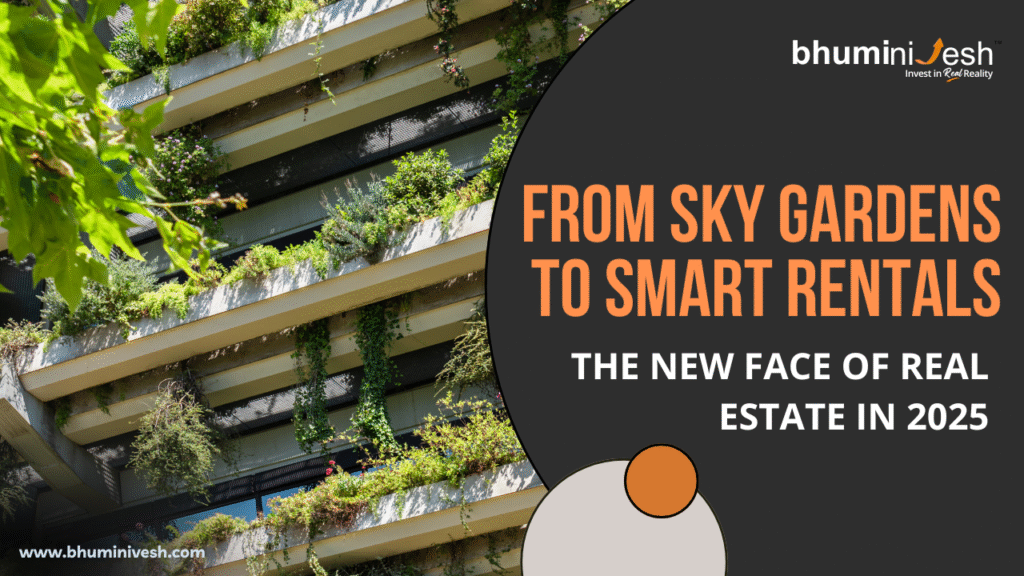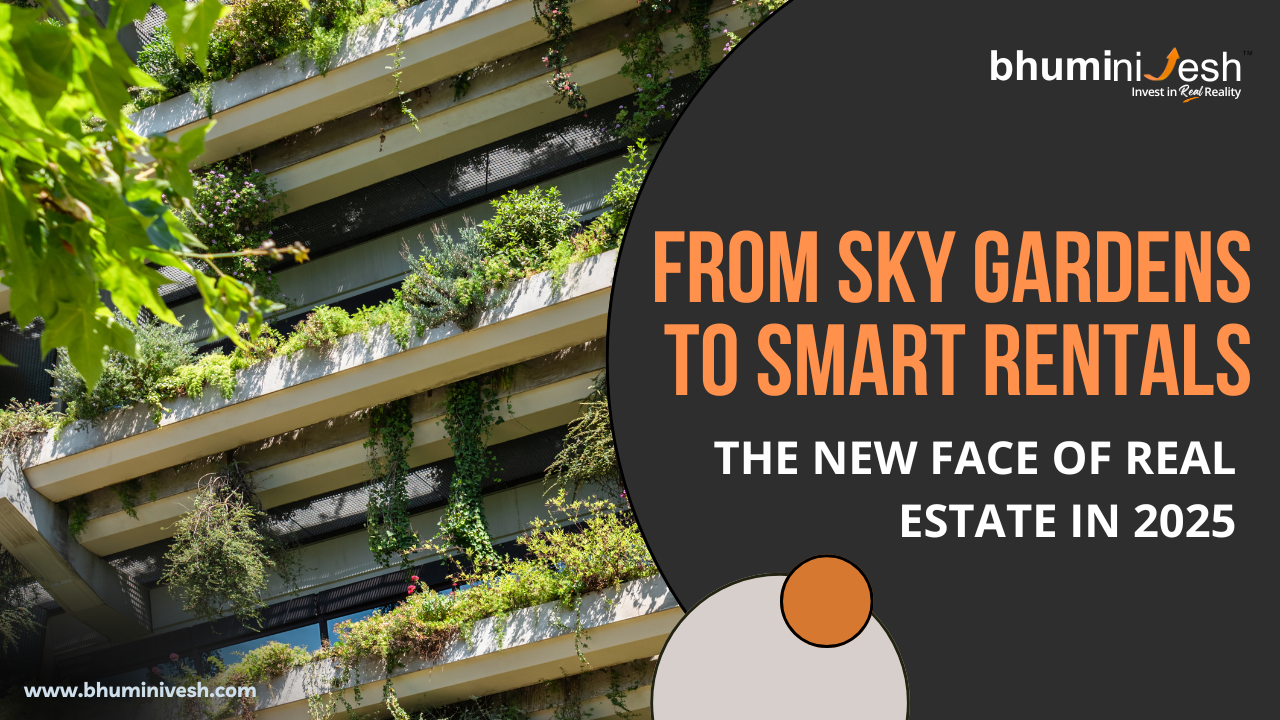
The real estate market in 2025 is no longer the slow-moving, traditional industry it once was. Technology, sustainability, and shifting lifestyle needs have sparked a massive transformation. Buyers and investors are now looking for much more than four walls and a roof — they want smart, adaptable, and eco-conscious living spaces.
Today’s property trends are shaped by urban challenges, environmental concerns, and the need for convenience. Developers are embracing futuristic designs, smart technology, and flexible ownership models to meet the evolving demands of a new generation.
Here are the top real estate trends of 2025 that are reshaping how we live, work, and invest.
1. Sky Gardens & Vertical Living
Urban areas are running out of buildable land, but creativity is reaching new heights — literally. High-rise buildings are now more than just steel and glass towers; they’re becoming vertical neighborhoods with lush, functional green spaces.
Sky gardens have emerged as a signature feature in luxury and mid-tier residential projects. These elevated parks offer fresh air, relaxation zones, and even community vegetable gardens. Residents can enjoy a touch of nature without leaving the building, a big win in cities where parks are few and far between.
Some developers are going further by introducing vertical farms and hydroponic greenhouses into building designs. This allows residents to grow herbs, fruits, and vegetables year-round — a sustainable solution that also promotes community bonding.
For investors, buildings with integrated green spaces tend to command higher rental yields and resale values due to their unique lifestyle appeal.
2. Smart Rentals & Digital Tenancy
Gone are the days of phone calls, paperwork, and chasing landlords for repairs. Smart rentals powered by proptech solutions are redefining the rental experience for both tenants and landlords.
Tenants can now:
Sign digital leases within minutes.
Pay rent automatically through secure apps.
Log maintenance requests with instant tracking.
Access smart locks and keyless entry systems.
Landlords benefit from AI-driven tools that help screen tenants, predict market rental rates, and automate property management tasks. Blockchain-based smart contracts also ensure secure, transparent, and tamper-proof agreements.
This tech-driven model reduces delays, increases transparency, and improves tenant satisfaction — a win-win for all parties.
3. Work-from-Anywhere Homes
Remote work is here to stay, and it’s shaping housing demand like never before. Homebuyers now prioritize dedicated workspaces when choosing a property.
Developers are responding with designs that include:
Soundproof home offices for video calls.
Built-in co-working spaces for residents.
High-speed fiber internet as standard.
Flexible layouts for multi-purpose rooms.
The flex home concept is gaining traction — rooms that can easily transform from offices to bedrooms or gyms using modular furniture and smart design.
Properties marketed as remote work-friendly are now selling faster and commanding premium prices.
4. Sustainable & Net-Zero Developments
Sustainability has moved from a “nice-to-have” to a “must-have” in real estate. Climate-conscious buyers are seeking net-zero homes — properties that generate as much energy as they consume.
Key features include:
Solar panels with battery storage.
Rainwater harvesting for irrigation and household use.
Energy-efficient appliances and insulation.
Smart thermostats to reduce wastage.
Governments are incentivizing green building through tax benefits and certifications, making eco-friendly homes even more attractive.
Eco-conscious design not only helps the planet but also reduces long-term utility costs, making it a financially sound choice for buyers.
5. The Rise of Fractional Ownership
High property prices have made traditional homeownership difficult for many, but fractional ownership offers a new way in.
This model allows multiple buyers to co-own a property, splitting both the purchase cost and usage rights. Managed through legal structures or online platforms, fractional ownership is becoming especially popular for:
Vacation homes.
Luxury villas.
Commercial spaces.
Investors enjoy the perks of high-value property ownership without shouldering the full financial burden. Plus, properties can be rented out when not in use, generating passive income for all co-owners.
Fractional ownership is expected to grow rapidly as real estate tokenization gains traction — allowing shares of a property to be bought, sold, or traded like stocks.
6. Immersive Property Shopping with AR/VR
Property buying has gone digital — and now it’s going immersive. Augmented reality (AR) and virtual reality (VR) tools let buyers explore homes in full detail without setting foot on-site.
Benefits for buyers:
360° virtual tours from anywhere in the world.
Ability to change furniture layouts, wall colors, and lighting virtually.
Visualization of renovation ideas before purchase.
For developers and agents, this tech makes it possible to sell pre-construction properties by showcasing lifelike 3D models. This drastically reduces sales timelines and widens the buyer pool to include overseas investors.
7. Community-Centric Living Spaces
Modern buyers are not just purchasing a home — they’re buying into a community. Developers are designing mixed-use spaces where residents have access to co-working hubs, gyms, cafés, and event spaces within their complex.
These lifestyle-first communities foster social interaction and provide convenience without the need to travel far. In many cases, they also integrate sustainability features like carpool programs and recycling hubs.
Properties with strong community infrastructure often enjoy higher occupancy rates and stronger resale value.
The Future: Lifestyle-First Real Estate
The real estate market in 2025 is dynamic, tech-powered, and lifestyle-oriented. Buyers expect properties to align with their values — whether that means eco-conscious living, remote work support, or cutting-edge technology.
For industry professionals, the takeaway is clear: innovation is no longer optional. Developers, agents, and investors who embrace these trends will stay ahead, while those clinging to outdated models risk being left behind.
Real estate is no longer about square footage — it’s about smart footage that maximizes value, comfort, and sustainability. The future is here, and it’s greener, smarter, and more connected than ever before.


